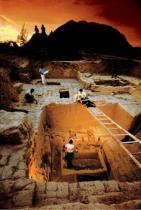On the trail of The Silver Spider, Part 2: the Sipan Spider
The Sipán spiders are fist-sized amulets that hung from a necklace, all of them solid gold. The body of the spider is a human face, so the effect is quite striking. Grotesque but beautiful at the same time. Seeing and holding this 1700 year old artwork made enough of an impression on me that I would use it as inspiration for The Silver Spider, which features a pre-Columbian treasure hoard - including a Sipán-like spider made of silver. How did it end up in Panama? And how ever did Charlie Parker, canal engineer and adventurer, come across it? These are just some of the mysteries that puzzle the protagonists of *The Silver Spider*.
Curious to learn more? The burials in Sipán were discovered in 1987 after tomb robbers unearthed a number of amazing artifacts, leading an archaeological team led by Walter Alva to secure the site. The spectacular finds featured on the cover of National Geographic Magazine in December 1987, as well as in many other periodicals in the world press. Click on the cover image of my book, The Silver Spider, for an image of the spider. The photo here was in the National Geographic spread and gave us a good chuckle at the time. Night-time excavations? In Peru, where no archaeological team works past 3 or 4PM? And with a person posed at every imaginable angle? Right. One of the members of my excavation team was present at the photo shoot and said it took hours!
